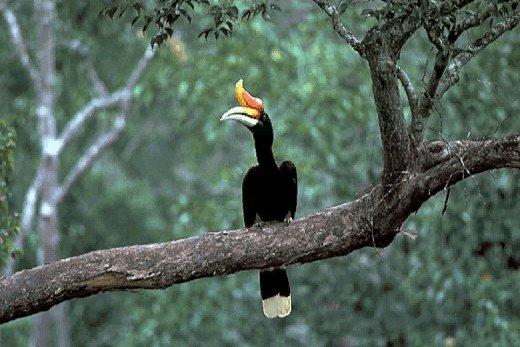|
| 질의: Buceros rhinoceros | 결과: 6번째/33 | |
Rhinoceros Hornbill (Buceros rhinoceros) (코뿔새)
| 제목: | Rhinoceros Hornbill (Buceros rhinoceros) (코뿔새)
| |

| 해상도: 520x347
파일크기: 43404 Bytes
등록시간: 2005:03:11 19:10:43
|
Personal or educational Use Only
Captured from
"Earth's Endangered Environments",
National Geographic Society, 1994
Rhinoceros Hornbill (Buceros rhinoceros)
Comments
========
From: eric.kowalczyk@zoo.org
Date: Sat Aug 14 28:46:36 KST 1999
File To Comment: animal2/NGS-Rhinoceros Hornbill-On Log.jpg
You are correct here...this is a Rhino. hornbill!!!!
Other photos are of other species. FYI
|
댓글 |
|---|
| | 손님 |
|
Rhinoceros Hornbill (Buceros rhinoceros)
--------------------------------------------------------------------------------
Family: BUCEROTIDAE
Hornbills are large, black or brown, and white, mainly arboreal birds, with long, heavy bills. Many species have large protuberant casques on top of the bill which may be gaudily coloured. Hornbills are found throughout Africa and tropical Asia, and throughout Indonesia to New Guinea. They eat fruit and insects and have harsh, penetrating calls.
The nesting habits of the family are interesting. The incubating females are usually sealed into tree hole nests with mud, leaving only a small aperture through which food can be passed by the male. When the young are hatched the female breaks out but reseals the nest entrance again until the young are ready to leave. Ten species of hornbill occur in Sumatra, eight in Borneo, but only three are found in Java.
Description: Very large (110 cm), black and white hornbill with large yellow and red bill and casque, and diagnostic white tail with a broad black band. Head, back, wings, and breast black; belly and thighs white.
Iris-white to blue in females, red in males; skin around eyes-dark grey; bill yellow with red base and surmounted by upturned spiralling casque; feet-greenish grey.
Voice: Loud, harsh roar kronnk, repeated by either sex and often given in chorus with one partner slightly later than the other. Sharper gak note given just before flight.
Range: SE Asia, Malay Peninsula, Sumatra, Borneo, Borneo, and Java. Absent from Bali.
Distribution and Status: This species is found in low densities in most large blocks of lowland and hill forest. It is very conspicuous because of its size, habits, and call but in fact is generally present at low density.
Habits: Pairs inhabit the crowns of the tallest trees. A regular visitor to fruiting giant strangling figs. Gives a dramatic whooshing sound of wing-beats in flight. |
| | cialis |
|
| 5ZFGaI idmzdygu bqctqqvr hobxvzpo |
| | none of your busniess |
|
| boring animals |
^o^
동물그림창고 똑똑전화 누리집
^o^
|
|
|